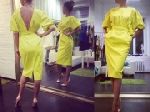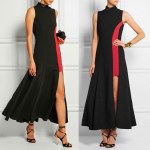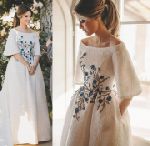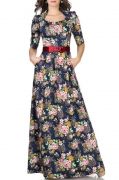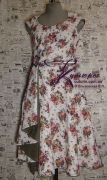Size charts What is the height of the pattern Payment methods Ask a question Reviews
PDF pattern for printing on a printer or plotter in full size for dress sizes from 42 to 52 (all sizes in one file).
How to sew a detachable dress with an open back with your own hands
Contents of the instructions for the pattern:
- Description of patterns for a dress, pattern format and style options.
- How to download and print electronic dress patterns on paper.
- Features of cutting various styles of a cut-off dress according to a finished pattern.
- Instructions on how to sew this dress step by step.
Download a pattern of a detachable dress with an open back
Description of patterns for a dress, pattern format and style options
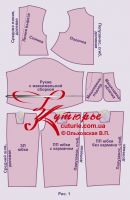
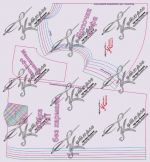 Sizes: 42-52 (the buyer receives the entire gradation of sizes).
Sizes: 42-52 (the buyer receives the entire gradation of sizes).
File format for download in order:
PDF in full size and without seam allowances.
After paying for the order, you will receive links to download two files dress patterns gradation sizes from 42 to 52:
- PDF file A4, adapted for printing patterns on sheets of A4 paper in any program on any device, including mobile phones.
- Multi-format PDF file for printing on sheets of any size from A0 to A4 on a printer or plotter using Adobe Reader.
Sewing difficulty level: medium or easy (depending on the presence or absence of a pocket). But in any case, this pattern is not suitable for beginner couturier.
If you have chosen this dress, then you need to be able to try on, sew on a “lightning” and process the neckline with a piping. This is a minimum, and maximalists will have to process a pocket of the “cut-off barrel” type.
Some more variations of this style are possible - a deep neckline can be replaced with a figured neckline or a neckline can be processed “under the neck”.
The set of patterns for a cut-off dress with an open back, ruffles and soft folds on the skirt includes (picture 1):
- bodice patterns - a shelf and a back with a cutout line;
- skirt patterns - back half (ZP), front half (PP) without pocket, front half with pocket;
- a sleeve with a maximum assembly - for the entire width of the fabric;
- patterns for sewing a pocket - burlap-valance and burlap-turning.
Patterns of cuffs and belts are not included in the set of patterns, as these are rectangles and recommendations for their I will reveal the data below.
Fabric consumption for a dress and what to sew from
The maximum consumption with the cutting of the belt and pocket details will be 230 cm with a width of 140 cm. Without the belt and pocket details, the consumption will be reduced to 200 cm.
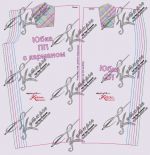 Skirt length (Du) according to the pattern - 65 cm.
Skirt length (Du) according to the pattern - 65 cm.
This style of dress, unfortunately, is only suitable for slender figures of any height. The length of the bodice is adjustable during the fitting.
Only thin and stable fabrics of the range are suitable for sewing. Among them, cotton shirting, thin linen, cambric, poplin or dense thin silk will be the most suitable. But from the silk range, neither chiffon nor crepe chiffon will do.
How to download and print electronic dress patterns on paper
How to choose a size without using size charts and without taking measurements...
How to buy and download a pattern...
How to print a pattern at home in full size on sheets of any size.
Download free dress patterns...
Download this cutting dress pattern
Features of cutting various styles of a cut-off dress according to a finished pattern
 As usual, we start by thinking about style variations: do we need pockets, do we need a neckline on the back, will the belt be part of the dress, as in the photo or a removable part.
As usual, we start by thinking about style variations: do we need pockets, do we need a neckline on the back, will the belt be part of the dress, as in the photo or a removable part.
For pockets, see video on sewing similar pockets
And I advise you to outline the cutout, but not to do it before trying it on. The fact is that for most figures the cutout will not be complementary.
Typically, such necklines look good in inflectional figures (Ds is much shorter than Dpt). But even a kinky figure may have some features of the back structure that are best hidden. In addition, the shape, volume of the breast and the properties of the fabric should allow its owner not to wear a bra. In other words, the cutout shown in the photo will fit only a few. The rest can choose a figured cutout in the shape of a heart or a drop (more details in Fig. 4 and below)
Now directly about the features of cutting.
At first glance, everything is simple - the fabric is folded in half face inward, the edges are aligned, the cut details are laid out in the most economical way, taking into account allowances for seams and a share direction (picture 1).
 If you chose a dress without pockets, the layout in figure 2if with pockets - in figure 3.
If you chose a dress without pockets, the layout in figure 2if with pockets - in figure 3.
Seam allowances are also usual: we do not add allowances for the waist, armhole, neckline and sleeve sections; along the bottom of the bodice 3 cm (such an allowance is needed for trying on and will save the product if it “sits down” after washing), along the bottom of the skirt - 2 cm for hem.
Pattern of cuffs and belt for a dress
Belt and cuffs - strips of fabric. We will need two of them.
Width of the belt when cutting = width of the belt in finished form + 2 cm
Cuff width when cutting = 2 finished widths + 2 cm
Cuff length when cutting = Op (shoulder coverage) + 6 cm (calculation for a sleeve with a slot).
We cut out the back without a cutout, but we outline the cutout line on the details of the cut in order to decide whether we will do it during the fitting.
An important detail is the facing for processing the neck. It is cut out according to the product or according to the same patterns as the front and back of the bodice (picture 4).
It is better to cut out the facing after trying on the product, when the shoulder seams are already processed and carefully ironed.
Facings are cut out of dublerin or non-woven fabric without allowances for seams and glued onto the remnants of the fabric in an arbitrary shared direction. Then, cut out with seam allowances.
Please note that seam allowances for piping are added only at the junctions of the piping fragments.
The share direction for turning is arbitrary, but it is very important that there are no additional stitches in the back cutout area.
One more thing about the sleeve. The peculiarity of this style is dimensionlessness, therefore, we do not add allowances, but we compare the length of the sleeve with the desired one. The gradation of sizes in this case is also useless and is done only "for the love of art."
Instructions how to sew this dress step by step
1. Preparing the bodice of the dress for fitting.
The sewing sequence of this dress, like the rest of the detachable dresses, begins with the preparation of the bodice for fitting.
With the seeming simplicity of this operation, explanations will not hurt.
We start by making assemblies at a distance of 4 - 5 cm from the lower cut of the bodice. Remember the big hem allowance? The assembly must be above the allowance. Pay attention to the fact that the assembly at the waist should not be uniform - the largest raft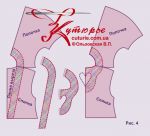 towards the center of the shelf. On the back, the assembly is small, so its uniformity does not matter much.
towards the center of the shelf. On the back, the assembly is small, so its uniformity does not matter much.
2. Preparing the dress skirt and sleeves for fitting
Preparing a skirt for trying on consists in sweeping the warehouse and processing pockets. At the end, the side and middle seams are swept, the lightning is swept.
Sleeve: a slot is made, a seam is grinded, assembly along the rim and along the bottom - a greater density along the top of the rim and the outer side along the bottom, less - under the armpit and under the arm.
So, for the fitting, the bodice, skirt and sleeve must be completely processed. In addition to them, we need a belt (detail) and an elastic band.
3. Fitting Dresses
- First, we try on the bodice, tying it up like a belt with a linen elastic band. There should not be a lap, so we pull it up and draw a waist line on the bodice along the elastic band.
- Then, we take the belt-piece and impose it so that the lower cut touches the linen gum. We outline the length of the belt according to the figure with a slight tightening and pin it to continue the fitting.
- We put on a skirt, pin the sleeve to the collar with 2-3 pins. We evaluate the view and make adjustments if necessary.
- Now you need to finally decide whether you need a cutout on the back and whether the belt will be part of the dress or a removable part.
 While we decide, we roll up the sleeves and try on again.
While we decide, we roll up the sleeves and try on again.
4. The sequence of work after trying on the dress
After trying on the bodice, we cut out the facing of the neckline and the cutout of the back (picture 4). We process the neckline and neckline. We stitch the sleeves. We shift the assembly of the bodice up along the waist as much as necessary and connect the bodice with the belt-detail (top / front), having previously duplicated it. At the same time, the allowances for the seams of the belt are not duplicated.
This belt should have a transitional part on the right side, it should “protrude” 4 cm beyond the middle seam of the skirt, while on the left side the protrusion is 1 cm for the seam.
The upper belt is connected to the skirt, and then the lower / purl belt is sewn on. It doesn't need to be duplicated.
If the belt is not part of the dress, then everything is much simpler: the bodice is connected to the skirt.
Download this pattern pdf:
Pattern "cut-off dress with an open back and assembly"
$2.00 (80 hryvnia)
Bank cards of the Russian Federation are not accepted for payment!
Size charts What is the height of the pattern Payment methods Ask a question Reviews
Vera Olkhovskaya in social networks:

See similar clothing patterns and how to sew on them
-
Any pattern for free for a review of a previously made order
More...
Lifetime promotion for buyers of patterns!

Leave a review about my store of patterns for an order that you made before, and you will receive any paid pattern of your choice Free!
